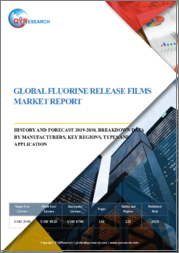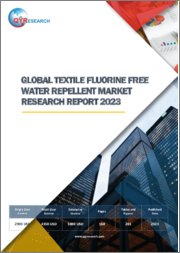
|
시장보고서
상품코드
1279699
세계의 불소 시장(2023-2030년)Global Fluorine Market - 2023-2030 |
||||||
시장 개요
세계 불소 시장은 2022년 10억 6,730만 달러에 달할 것으로 예상되며, 2030년에는 12억 4,780만 달러에 달할 것으로 예측됩니다. 이 시장은 예측 기간(2023-2030년) 동안 4.2%의 CAGR로 성장할 것으로 예상됩니다.
세계 불소 시장은 알루미늄 생산, 냉동, 화학 산업 등 여러 산업에서 불소 제품 수요 증가 등 다양한 시장 촉진요인으로 인해 최근 몇 년 동안 크게 성장하고 있습니다. 정부 소식통에 따르면 많은 불소 제품의 주요 구성 요소인 불화수소산은 2022년 불소 화학제품의 총 생산량과 시장 점유율의 약 75%를 차지할 것으로 예상됩니다. 또한 불소 수지, 불소 가스 등 불소계 제품은 다양한 응용 분야에서 광범위하게 사용되기 때문에 시장 추세는 상승세를 보이고 있습니다.
또한 전기자동차와 같은 첨단기술 응용분야에 널리 사용되는 리튬이온 배터리의 수요 증가로 불소의 시장기회가 확대되고 있습니다. 리튬이온전지의 주성분인 불화수소산의 수요는 향후 증가할 것으로 예상되어 불소 시장에 새로운 시장 기회를 창출하고 있습니다. 또한, 항공우주 산업과 자동차 산업에서 불소계 제품 사용 추세가 강화되고 있어 향후 몇 년 동안 시장 성장을 견인할 것으로 예상됩니다. 새로운 시장 기회 창출과 혁신적인 기술 개발로 불소 시장의 미래는 유망할 것으로 보입니다.
시장 역학
불소 제품에 대한 수요 증가
세계 불소 시장의 가장 큰 원동력은 알루미늄 제조, 냉동, 화학 산업 등 다양한 산업에서 불소 제품에 대한 수요 증가입니다. 또한 자동차 산업, 항공우주 산업, 전기자동차용 리튬이온 배터리 제조 등 하이테크 분야에서도 불소 제품 사용이 증가하고 있습니다. 미국 지질조사국(USGS)에 따르면 불화수소산은 전 세계에서 소비되는 가장 중요한 불소계 화학제품로, 불소계 화학제품 총 생산량의 약 75%를 차지합니다. 불화수소산은 냉매, 플라스틱, 의약품, 알루미늄 등 많은 불소계 제품의 중요한 구성 요소입니다. 불화수소산의 수요는 이러한 산업에서의 사용과 리튬 이온 배터리 제조에 대한 역할에 의해 주도되고 있습니다. 결론적으로, 불소 세계 시장 점유율의 가장 큰 요인은 다양한 산업에서 불소 제품에 대한 수요 증가, 특히 많은 불소 제품의 주요 구성 요소인 불화수소산에 대한 수요 증가입니다.
불소 제품 사용 및 폐기에 대한 환경 규제 및 우려
세계 불소 시장의 가장 큰 억제요인 중 하나는 불소 제품 사용 및 폐기에 대한 환경 규제와 우려입니다. 미국 환경보호청(EPA)은 불소 제품의 사용 및 폐기와 관련하여 불소 가스의 대기 중 방출 가능성, 물과 토양 오염, 인간과 야생동물에 대한 건강 영향 가능성 등 여러 가지 우려를 제기하고 있습니다. 또한, EPA는 불소계 제품을 포함한 오존층 파괴 물질에 대한 안전한 대체 물질을 식별하고 사용을 촉진하는 SNAP(Significant New Alternatives Policy) 프로그램과 같은 규제를 시행하고 있습니다.
이러한 규제와 우려는 불소 시장의 주요 제품인 불화수소산, 냉매, 불소 수지 등 불소계 제품의 생산과 수요에 영향을 미칠 수 있습니다. 그럼에도 불구하고 세계 불소 시장이 지속적으로 성장하기 위해서는 이러한 환경적 우려를 완화하고 규제 요건을 충족시킬 수 있는 새롭고 혁신적인 기술과 공정을 개발해야 합니다.
COVID-19 영향 분석
COVID-19 분석에는 Pre-COVID 시나리오, COVID 시나리오, Post-COVID 시나리오가 있으며, 가격 역학(팬데믹 기간 및 팬데믹 이후 가격 변동과 COVID 이전 시나리오와의 비교), 수요-공급 스펙트럼(거래 제한, 락다운), 정부의 노력(정부, 산업, 시장, 부문, 제조업체의 활성화 노력) 다운 및 그 이후의 문제로 인한 수요와 공급의 변화), 정부의 노력(정부 기관의 시장, 부문 및 산업 활성화 노력), 제조업체의 전략적 노력(제조업체가 COVID 문제를 완화하기 위해 무엇을 했는지)도 포함됩니다.
목차
제1장 조사 방법과 범위
- 조사 방법
- 조사 목적 및 조사 범위
제2장 정의와 개요
제3장 주요 요약
- 제품별 내역
- 내역 : 용도별
- 지역별 내역
제4장 시장 역학
- 영향요인
- 성장 촉진요인
- 불소계 제품 수요 확대
- 성장 억제요인
- 불소계 제품 사용과 폐기에 관한 환경 규제로 우려
- 기회
- 영향 분석
- 성장 촉진요인
제5장 산업 분석
- Porter's Five Forces 분석
- 공급망 분석
- 가격 분석
- 규제 분석
제6장 COVID-19 분석
- COVID-19 분석
- COVID-19의 전 시나리오
- COVID-19 기간 중 시나리오
- COVID-19 이후 시나리오 또는 향후 시나리오
- COVID-19 중에서의 가격·역학
- 수급 스펙트럼
- 팬데믹 동안 시장과 관련된 정부 이니셔티브
- 제조업체의 전략적 이니셔티브
- 요약
제7장 제품별
- 플루오라이트
- 크라이오라이트
- 플루오라파타이트
제8장 용도별
- 합성 화학 재료
- 의약품
- 살충제
- 플라스틱
- 전자부품 세정
- 기타
제9장 지역별
- 북미
- 미국
- 캐나다
- 멕시코
- 유럽
- 독일
- 영국
- 프랑스
- 이탈리아
- 러시아
- 기타 유럽
- 남미
- 브라질
- 아르헨티나
- 기타 남미
- 아시아태평양
- 중국
- 인도
- 일본
- 호주
- 기타 아시아태평양
- 중동 및 아프리카
제10장 경쟁 상황
- 경쟁 시나리오
- 시장 상황/점유율 분석
- M&A(인수합병) 분석
제11장 기업 개요
- ADCO Global Inc
- 기업 개요
- 제품 포트폴리오와 설명
- 재무 개요
- 주요 발전 상황
- ACE Geosynthetics Enterprise Co., Ltd
- Aiello Chemical Co. Ltd
- Solvay
- Linde plc
- Air Liquide S.A
- AGC Inc
- Central Glass Co., Ltd
- Hyosung Chemical
- Zhuoxi Gas
제12장 부록
ksm 23.06.05Market Overview
The global fluorine market reached US$ 1,067.3 million in 2022 and is projected to witness lucrative growth by reaching up to US$ 1,247.8 million by 2030. The market is growing at a CAGR of 4.2% during the forecast period (2023-2030).
The global fluorine market has been experiencing significant growth in recent years, driven by various market drivers such as the increasing demand for fluorinated products in several industries, including aluminum production, refrigeration, and the chemical industry. According to government sources, hydrofluoric acid, a key building block for many fluorinated products, accounted for approximately 75% of the total fluorine chemical production and market share in 2022. Furthermore, the market trend for fluorinated products, such as fluoropolymers and fluorinated gases, is on the rise due to their extensive use in a variety of applications.
The market opportunities for the fluorine market are also expanding with the increasing demand for lithium-ion batteries, which are widely used in electric vehicles and other high-tech applications. The demand for hydrofluoric acid, a key component in lithium-ion batteries, is expected to rise in the coming years, creating new market opportunities for the fluorine market. Additionally, the growing trend toward the use of fluorinated products in the aerospace and automotive industries is expected to drive market growth in the coming years. With new market opportunities emerging and innovative technologies being developed, the future of the fluorine market looks promising.
Market Dynamics
The Growing Demand For Fluorinated Products
The biggest driver for the global fluorine market is the growing demand for fluorinated products in various industries, including aluminum production, refrigeration, and the chemical industry. The use of fluorine-based products is also increasing in the automotive and aerospace industries, as well as in the production of lithium-ion batteries for electric vehicles and other high-tech applications. According to the United States Geological Survey (USGS), hydrofluoric acid is the most important fluorine chemical consumed worldwide, accounting for approximately 75% of the total fluorine chemical production. Hydrofluoric acid is a key building block for many fluorinated products, including refrigerants, plastics, pharmaceuticals, and aluminum. The demand for hydrofluoric acid is driven by its use in these industries, as well as its role in the production of lithium-ion batteries. In conclusion, the biggest driver for the global fluorine market share is the growing demand for fluorinated products in various industries, especially the demand for hydrofluoric acid, which is a key building block for many fluorinated products.
Environmental Regulations And Concerns Regarding The Use And Disposal Of Fluorinated Products
One of the biggest restraints for the global fluorine market is environmental regulations and concerns regarding the use and disposal of fluorinated products. The US Environmental Protection Agency (EPA) lists several concerns regarding the use and disposal of fluorinated products, including the potential release of fluorinated gases into the atmosphere, the contamination of water and soil, and the potential health effects on humans and wildlife. The EPA has also implemented regulations such as the Significant New Alternatives Policy (SNAP) program, which identifies and promotes the use of safer alternatives to ozone-depleting substances, including fluorinated products.
These regulations and concerns can impact the production and demand for fluorinated products, including hydrofluoric acid, refrigerants, and fluoropolymers, which are key products in the fluorine market. Nonetheless, the development of new and innovative technologies and processes that can mitigate these environmental concerns and meet regulatory requirements is necessary to ensure the sustainable growth of the global fluorine market.
COVID-19 Impact Analysis
The COVID-19 analysis includes Pre-COVID Scenario, COVID Scenario and Post-COVID Scenario along with pricing dynamics (including pricing change during and post-pandemic comparing it with pre-COVID scenarios), demand-supply spectrum (shift in demand and supply owing to trading restrictions, lockdown and subsequent issues), government initiatives (initiatives to revive market, sector or industry by government bodies) and manufacturers strategic initiatives (what manufacturers did to mitigate the COVID issues will be covered here).
Segment Analysis
The global fluorine market is segmented based on product, application and region.
The Use Of Fluorspar In The Production Of Hydrofluoric Acid, Which Is A Key Building Block For Many Fluorinated Products
According to the United States Geological Survey (USGS), fluorspar accounted for approximately 64% of global fluorine production in 2020. The use of fluorspar in the production of hydrofluoric acid, which is a key building block for many fluorinated products, is one of the main drivers of its market share in the fluorine market. The USGS also reports that China is the largest producer of fluorspar globally, accounting for approximately 50% of the world's production in 2020. Other significant producers of fluorspar include Mexico, Mongolia, South Africa, and Russia, among others.
The demand for fluorspar in the global market is driven by several factors, including the growing demand for fluorinated products in various industries, including aluminum production, refrigeration, and pharmaceuticals. The use of fluorspar in the production of lithium-ion batteries, which are used in electric vehicles and other high-tech applications, is also expected to increase in the coming years, further driving the market share of fluorspar in the global fluorine market.
Geographical Analysis
The Growing Demand For Fluorinated Products In Industries Such As Chemicals, Electronics, And Pharmaceuticals
The North American fluorine market occupies around 22% of the global fluorine market, which is expected to experience strong growth in the coming years. The North American fluorine market is driven by several factors, including the growing demand for fluorinated products in industries such as chemicals, electronics, and pharmaceuticals. The use of fluorine in refrigerants and air conditioning systems is also a significant driver of the market, as there is a growing need for more environmentally friendly alternatives to traditional refrigerants.
The U.S. is the largest consumer of fluorine in North America, accounting for the majority of the regional market share. The demand for fluorine in the country is driven by the chemical industry, which uses the element in the production of a range of products, including pharmaceuticals, plastics, and solvents. The electronics industry is also a significant consumer of fluorine, as it is used in the production of semiconductors and other electronic components.
Competitive Landscape
The major global players include: ADCO Global Inc, ACE Geosynthetics Enterprise Co., Ltd, Aiello Chemical Co. Ltd, Solvay, Linde plc, Air Liquide S.A, AGC Inc, Central Glass Co., Ltd, Hyosung Chemical and Zhuoxi Gas.
Why Purchase the Report?
- To visualize the global fluorine market segmentation based on product, application and region, as well as understand key commercial assets and players.
- Identify commercial opportunities by analyzing trends and co-development.
- Excel data sheet with numerous data points of fluorine market-level with all segments.
- PDF report consists of a comprehensive analysis after exhaustive qualitative interviews and an in-depth study.
- Product mapping is available in Excel consisting of key products of all the major players.
The global fluorine market report would provide approximately 53 tables, 50 figures and 162 Pages.
Target Audience 2023
- Manufacturers/ Buyers
- Industry Investors/Investment Bankers
- Research Professionals
- Emerging Companies
Table of Contents
1. Methodology and Scope
- 1.1. Research Methodology
- 1.2. Research Objective and Scope of the Report
2. Definition and Overview
3. Executive Summary
- 3.1. Snippet by Product
- 3.2. Snippet by Application
- 3.3. Snippet by Region
4. Dynamics
- 4.1. Impacting Factors
- 4.1.1. Drivers
- 4.1.1.1. The growing demand for fluorinated products
- 4.1.2. Restraints
- 4.1.2.1. Environmental regulations and concerns regarding the use and disposal of fluorinated products
- 4.1.3. Opportunity
- 4.1.4. Impact Analysis
- 4.1.1. Drivers
5. Industry Analysis
- 5.1. Porter's Five Forces Analysis
- 5.2. Supply Chain Analysis
- 5.3. Pricing Analysis
- 5.4. Regulatory Analysis
6. COVID-19 Analysis
- 6.1. Analysis of COVID-19
- 6.1.1. Scenario Before COVID-19
- 6.1.2. Scenario During COVID-19
- 6.1.3. Post COVID-19 or Future Scenario
- 6.2. Pricing Dynamics Amid COVID-19
- 6.3. Demand-Supply Spectrum
- 6.4. Government Initiatives Related to the Market During Pandemic
- 6.5. Manufacturers Strategic Initiatives
- 6.6. Conclusion
7. By Product
- 7.1. Introduction
- 7.1.1. Market Size Analysis and Y-o-Y Growth Analysis (%), By Product
- 7.1.2. Market Attractiveness Index, By Product
- 7.2. Fluorite*
- 7.2.1. Introduction
- 7.2.2. Market Size Analysis and Y-o-Y Growth Analysis (%)
- 7.3. Cryolite
- 7.4. Fluorapatite
8. By Application
- 8.1. Introduction
- 8.1.1. Market Size Analysis and Y-o-Y Growth Analysis (%), By Application
- 8.1.2. Market Attractiveness Index, By Application
- 8.2. Synthetic Chemical Materials*
- 8.2.1. Introduction
- 8.2.2. Market Size Analysis and Y-o-Y Growth Analysis (%)
- 8.3. Pharmaceuticals
- 8.4. Pesticides
- 8.5. Plastic
- 8.6. Electronic Cleaning
- 8.7. Others
9. By Region
- 9.1. Introduction
- 9.1.1. Market Size Analysis and Y-o-Y Growth Analysis (%), By Region
- 9.1.2. Market Attractiveness Index, By Region
- 9.2. North America
- 9.2.1. Introduction
- 9.2.2. Key Region-Specific Dynamics
- 9.2.3. Market Size Analysis and Y-o-Y Growth Analysis (%), By Product
- 9.2.4. Market Size Analysis and Y-o-Y Growth Analysis (%), By Application
- 9.2.5. Market Size Analysis and Y-o-Y Growth Analysis (%), By Country
- 9.2.5.1. The U.S.
- 9.2.5.2. Canada
- 9.2.5.3. Mexico
- 9.3. Europe
- 9.3.1. Introduction
- 9.3.2. Key Region-Specific Dynamics
- 9.3.3. Market Size Analysis and Y-o-Y Growth Analysis (%), By Product
- 9.3.4. Market Size Analysis and Y-o-Y Growth Analysis (%), By Application
- 9.3.5. Market Size Analysis and Y-o-Y Growth Analysis (%), By Country
- 9.3.5.1. Germany
- 9.3.5.2. The U.K.
- 9.3.5.3. France
- 9.3.5.4. Italy
- 9.3.5.5. Russia
- 9.3.5.6. Rest of Europe
- 9.4. South America
- 9.4.1. Introduction
- 9.4.2. Key Region-Specific Dynamics
- 9.4.3. Market Size Analysis and Y-o-Y Growth Analysis (%), By Product
- 9.4.4. Market Size Analysis and Y-o-Y Growth Analysis (%), By Application
- 9.4.5. Market Size Analysis and Y-o-Y Growth Analysis (%), By Country
- 9.4.5.1. Brazil
- 9.4.5.2. Argentina
- 9.4.5.3. Rest of South America
- 9.5. Asia-Pacific
- 9.5.1. Introduction
- 9.5.2. Key Region-Specific Dynamics
- 9.5.3. Market Size Analysis and Y-o-Y Growth Analysis (%), By Product
- 9.5.4. Market Size Analysis and Y-o-Y Growth Analysis (%), By Application
- 9.5.5. Market Size Analysis and Y-o-Y Growth Analysis (%), By Country
- 9.5.5.1. China
- 9.5.5.2. India
- 9.5.5.3. Japan
- 9.5.5.4. Australia
- 9.5.5.5. Rest of Asia-Pacific
- 9.6. Middle East and Africa
- 9.6.1. Introduction
- 9.6.2. Key Region-Specific Dynamics
- 9.6.3. Market Size Analysis and Y-o-Y Growth Analysis (%), By Product
- 9.6.4. Market Size Analysis and Y-o-Y Growth Analysis (%), By Application
10. Competitive Landscape
- 10.1. Competitive Scenario
- 10.2. Market Positioning/Share Analysis
- 10.3. Mergers and Acquisitions Analysis
11. Company Profiles
- 11.1. ADCO Global Inc*
- 11.1.1. Company Overview
- 11.1.2. Product Portfolio and Description
- 11.1.3. Financial Overview
- 11.1.4. Key Developments
- 11.2. ACE Geosynthetics Enterprise Co., Ltd
- 11.3. Aiello Chemical Co. Ltd
- 11.4. Solvay
- 11.5. Linde plc
- 11.6. Air Liquide S.A
- 11.7. AGC Inc
- 11.8. Central Glass Co., Ltd
- 11.9. Hyosung Chemical
- 11.10. Zhuoxi Gas
LIST NOT EXHAUSTIVE
12. Appendix
- 12.1. About Us and Services
- 12.2. Contact Us



















